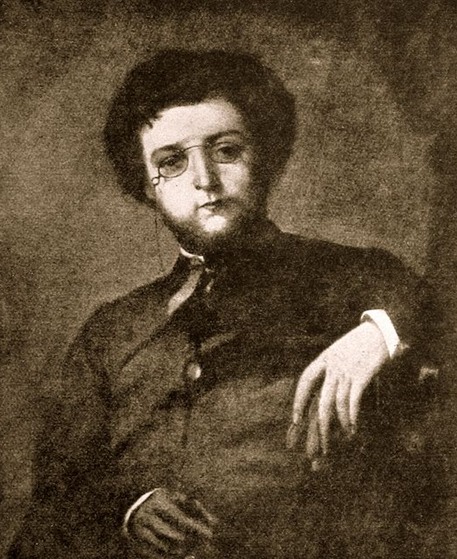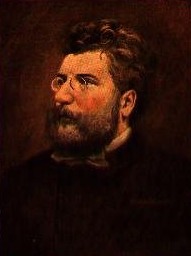Think that you may own a portrait of composer Georges Bizet? We authenticate, appraise, research and issue certificates of authenticity (COA) and provide consultations for all portraits of Georges Bizet.

Bizet
Georges Bizet was born in Paris, France at 26 rue de la Tour d'Auvergne. He was registered with the legal name Alexandre-César-Léopold Bizet, but was baptized Georges Bizet and was always known by the latter name. He entered the Paris Conservatory of Music a fortnight before his tenth birthday.

Bizet, age 19
His first symphony, the Symphony in C Major, was written there when he was seventeen, evidently as a student assignment. It seems that Bizet completely forgot about it himself, and it was not discovered again until 1935, in the archives of the Conservatory library. Upon its first performance, it was immediately hailed as a junior masterwork and a welcome addition to the early Romantic period repertoire. A delightful work (and a prodigious one, from a seventeen-year-old boy), the symphony is noteworthy for bearing an amazing stylistic resemblance to the music of Franz Schubert, whose work was virtually unknown in Paris at that time (with the possible exception of a few of his songs). A second symphony, "Roma" was not completed.

Bizet
In 1857 a setting of the one-act operetta Le docteur Miracle won him a share in a prize offered by Jacques Offenbach. He also won the Music Composition scholorship of the Prix de Rome, the conditions of which required him to study in Rome for three years. There, his talent developed as he wrote such works as the opera Don Procopio. Apart from this period in Rome, Bizet lived in the Paris area all his life.
His mother died shortly after his return to Paris. He composed the opera Les pêcheurs de perles (The Pearl Fishers) for the Theatre-Lyrique in 1863 and also around this time wrote the opera La jolie fille de Perth, the popular L'arlésienne originally produced as incidental music for a play, and Jeux d'enfants (Children's games) for the piano.
He also composed a romantic opera, Djamileh, which is often seen as a precursor to Carmen, 1875. This latter opera is Bizet's best-known work and is based on a novella of the same title written in 1846 by Prosper Mérimée. Bizet composed the title role for a mezzo-soprano.
Carmen was not initially well-received but praise for it eventually came from well-known contemporaries including Claude Debussy, Camille Saint-Saëns and Pyotr Tchaikovsky. Their views proved to be prophetic, as Carmen has since become one of the most popular operatic works. However Bizet did not live to see its success, as he died from angina at the age of 36 a few months after writing it, on his wedding anniversary. He was buried in the Père Lachaise Cemetery.
Bizet's music has been used in the twentieth century as the basis for several important ballets. The Soviet-era "Carmen Suite" (1967), set to music drawn from Carmen arranged by Rodion Shchedrin, gave the Bolshoi ballerina Maya Plisetskaya one of her signature roles; it was choreographed by Alberto Alonso. In the West the "l'Arlesienne" of Roland Petit is well-regarded, and the "Symphony in C" by George Balanchine is considered to be one of the great ballets of the twentieth century. It was first presented as "Le Palais de Crystal" by the Paris Opera Ballet in 1947, and has been in the repertory there ever since. The ballet has no story; it simply fits the music: each movement of the symphony has its own ballerina, cavalier, and corps de ballet, all of whom dance together in the finale.Bizet died in 1875 and is interred in Père Lachaise Cemetery in Paris, France.

Bizet by Mitterfellner, date unknown

Photo of Bizet
There are very few known portraits of Bizet in existence, and the ones that art historians do know about appear to be created from photographs. An authentic portrait of Bizet would be a rare find indeed. Still wondering about a 19th century portrait in your family collection? Contact us... it could be of Georges Bizet.
